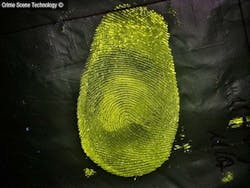Fluorescence technique detects fingerprints directly, rather than post-treatment
Cachan and Paris, France--A product that uses fluorescence to directly detect fingerprints has been developed by a team from the Laboratoire de Photophysique et Photochimie Supramoléculaire et Macromoléculaire (CNRS/ENS Cachan) in collaboration with the specialized French firm Crime Scene Technology. Called Lumicyano, the product will make it possible to highlight fingerprints directly, more rapidly, and at a lower cost, avoiding the cumbersome processes required until now, say the developers. The product has been successfully put through its paces by the French Police and Gendarmerie as well as by Scotland Yard and the FBI. It has led to a publication on the website of the journal Forensic Science International and a patent has been filed.
Fingerprints are essential evidence in numerous criminal investigations. However, scientific police can find it difficult to make use of such fingerprints when they are too light or their contrast is too low. When someone places their finger on an object, they leave behind a trace composed of water, salts, fats, amino acids, and, potentially, DNA.
To reveal this latent trace, the most widely used technique is fuming (spraying a substance in the atmosphere of an airtight enclosure) of a cyanoacrylate compound best known as "Super Glue." This reacts with the elements present in the fingerprint and polymerizes, leaving a white deposit that technicians can then photograph and analyze. However, this technique can at times entail certain difficulties. For example, when the fingerprint support is of light color, the contrast with the fingerprint is too low to be photographed. Similarly, if the fingerprint is very light, the deposit will be too tenuous to obtain an exploitable image.
In this case, crime scene investigators can opt for a second treatment using a colorant, which turns the fingerprint fluorescent. However, this post-treatment poses several problems. The products in question are toxic and carcinogenic and have to be used in a fume cupboard, whose cost is usually beyond the means of most police stations. In addition, this process can require up to 48 hours and can degrade the fingerprints through leaching, which in most cases compromises the sampling of DNA.
In a bid to overcome these problems, numerous chemists have been trying for the past three decades to come up with a product allowing fluorescent fingerprints to be detected directly. The newly developed Lumicyano allows this with the use of a conventional cyanoacrylate; to manage this, the researchers combined cyanoacrylate with a molecule of the tetrazine family, the smallest fluorescent colorants known to date. Tetrazine molecules are fumed along with the cyanoacrylate onto the fingerprint support and adhere to the deposit. In this way, using a simple UV lamp or forensic lighting techniques; the fluorescent traces are visible and can be photographed.
Lumicyano does not destroy the DNA that can sometimes be extracted from fingerprints. The product will be presented at the forthcoming Worldwide Internal State Security Exhibition (Milipol, Paris 2013), scheduled for 19-22 November 2013 in Paris Nord Villepinte.
About the Author
John Wallace
Senior Technical Editor (1998-2022)
John Wallace was with Laser Focus World for nearly 25 years, retiring in late June 2022. He obtained a bachelor's degree in mechanical engineering and physics at Rutgers University and a master's in optical engineering at the University of Rochester. Before becoming an editor, John worked as an engineer at RCA, Exxon, Eastman Kodak, and GCA Corporation.

